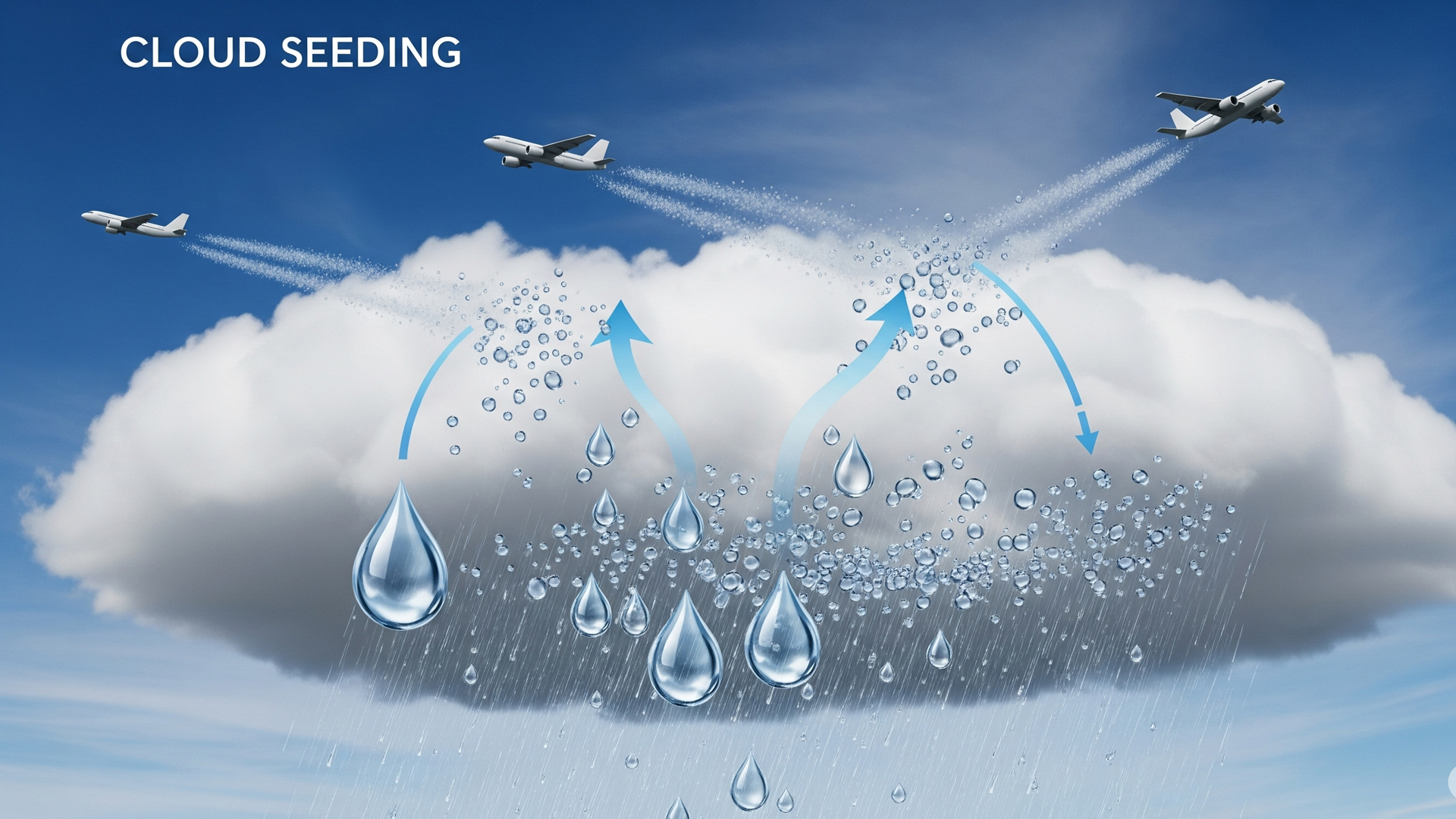In an era of increasing climate variability and growing concerns over freshwater resources, the concept of cloud seeding has moved from the fringes of science fiction to a tangible, actively deployed technology. This weather modification technique aims to enhance precipitation, mitigate droughts, and even suppress severe weather phenomena by influencing the microphysical processes within clouds.
What is Cloud Seeding?
At its core, cloud seeding is the process of introducing tiny particles, known as seeding agents, into clouds to stimulate or enhance precipitation. These agents act as artificial ice nuclei or condensation nuclei, providing a surface for water vapor to condense or freeze upon, thereby accelerating the natural rain or snow-making process.
The most common seeding agent used in cold clouds (those containing supercooled liquid water, i.e., water droplets colder than 0°C but still in liquid form) is silver iodide (AgI). Its crystalline structure is similar to that of ice, making it highly effective at triggering ice crystal formation. For warmer clouds, hygroscopic materials like sodium chloride (salt) are often used to encourage the growth of larger water droplets through coalescence.
How Does Cloud Seeding Work?
The process typically involves:
- Identification of suitable clouds: Not all clouds are amenable to seeding. Meteorologists analyze atmospheric conditions to identify clouds with sufficient moisture content and appropriate temperatures (often supercooled liquid water).
- Delivery of seeding agents: Seeding agents can be dispersed in several ways:
- Aircraft: Planes equipped with generators or flares release silver iodide or other agents directly into or above the target clouds. This method offers precision in targeting specific cloud formations.
- Ground-based generators: In mountainous regions, ground-based generators burn silver iodide flares, with the particles carried into the clouds by updrafts. This is often a more cost-effective option for consistent, long-term programs.
- Drones: Emerging technologies include the use of specialized drones for more localized and precise delivery.
- Initiation of precipitation: Once dispersed, the seeding agents interact with the cloud’s supercooled water droplets. In the case of silver iodide, ice crystals form and grow by collecting more supercooled droplets. When these ice crystals become heavy enough, they fall as snow or melt into rain as they descend through warmer air.
Benefits and Applications
Cloud seeding offers a range of potential benefits, particularly in regions grappling with water scarcity and drought mitigation.
- Increased Water Supply: The primary goal is to augment rainfall or snowfall, thereby increasing water availability for agriculture, municipal use, and replenishing reservoirs. States like California, Colorado, and Utah in the USA have long-standing cloud seeding programs to enhance snowpack in their crucial mountain ranges.
- Agricultural Enhancement: By providing more consistent precipitation, cloud seeding can significantly boost crop yields in arid and semi-arid regions, supporting food security.
- Wildfire Control: Increased moisture levels can help reduce the risk and intensity of wildfires.
- Hail Suppression: In some cases, cloud seeding is employed to reduce the size of hailstones, minimizing damage to crops and property.
- Fog Dispersal: Cloud seeding can also be used to dissipate fog at airports, improving visibility and enhancing air travel safety.
Environmental Considerations and Research
While promising, cloud seeding also raises questions regarding its environmental impacts. The primary concern often revolves around the long-term effects of introducing seeding agents, particularly silver iodide, into the ecosystem. However, numerous studies have indicated that the concentrations of silver iodide used are generally very low and pose minimal environmental risk. Further research continues into the potential for negative effects of cloud seeding to ensure long-term safety.
Ongoing cloud seeding research in the USA and globally continues to refine techniques, improve forecasting, and assess the broader ecological implications. Organizations like the Desert Research Institute (DRI) are at the forefront of this research, developing more efficient and environmentally sound methods for weather modification. Advances in radar validation, numerical weather modeling, and sustainable cloud seeds are paving the way for more precise and effective operations.
Current News on Cloud Seeding in Texas
Cloud seeding has recently been a prominent topic in Texas, particularly in the wake of severe flash floods experienced over the Fourth of July holiday weekend in 2025. While some social media claims attempted to link cloud seeding operations to the catastrophic flooding, meteorological experts and state officials have strongly refuted these assertions.
The Texas Department of Agriculture, which previously had oversight of weather modification but transferred this authority to the Texas Department of Licensing and Regulation (TDLR) in 2011, has clarified that it has no current involvement in cloud seeding programs . Texas Agriculture Commissioner Sid Miller addressed the misinformation directly, stating that there is no evidence to suggest cloud seeding caused the floods.

According to the TDLR, cloud seeding projects are indeed active in various parts of Texas, covering approximately 31 million acres, or about one-sixth of the state’s land area. These projects, primarily funded by underground water conservation districts and other local entities, operate in regions like West, Northwest, and South Texas. Key projects include:
- West Texas Weather Modification Association (WTWMA)
- South Texas Weather Modification Association (STWMA)
- Panhandle Groundwater Conservation District (PGWCD)
- Trans Pecos Weather Modification Association (TPWMA)
- Rolling Plains Water Enhancement Project
These programs generally aim to increase rainfall for drought mitigation and water supply augmentation. For example, the South Texas Weather Modification Association, based in Pleasanton, operates year-round to enhance precipitation from the Edwards Plateau to the coastal bend. The Panhandle Groundwater Conservation District focuses on recharging the Ogallala Aquifer.
Experts, including those from Texas A&M University and the University of Texas at Austin, emphasize that cloud seeding can only produce modest increases in precipitation (often cited as 10-30% in optimal conditions) from existing clouds. It cannot create storms out of clear skies or generate the immense rainfall seen in the recent Texas floods, which were driven by large-scale atmospheric conditions and an area already known as “Flash Flood Alley”. Any seeding agents dispersed would also have long since dissipated before the most intense rainfall. The CEO of Rainmaker, a cloud seeding company that conducted operations in Texas, also stated that their efforts were unrelated to the floods, emphasizing the vastly different scales of precipitation involved.
The controversy highlights the public’s interest and occasional misunderstanding of weather modification technologies, underscoring the importance of clear communication from scientific and governmental bodies.
The Future of Cloud Seeding
As climate change intensifies and puts further strain on global water resources, weather modification technologies like cloud seeding are gaining renewed attention. While not a standalone solution, it represents a valuable tool in a comprehensive water management strategy. The cloud seeding industry in the USA, featuring companies like Weather Modification, Inc. and Rainmaker, is continually innovating, developing new materials and deployment methods to make cloud seeding more efficient, cost-effective, and environmentally responsible. The potential for cloud seeding to contribute to a more water-secure future is significant, prompting continued investment in research and development, and discussions on cloud seeding effectiveness continue to inform policy and practice.


